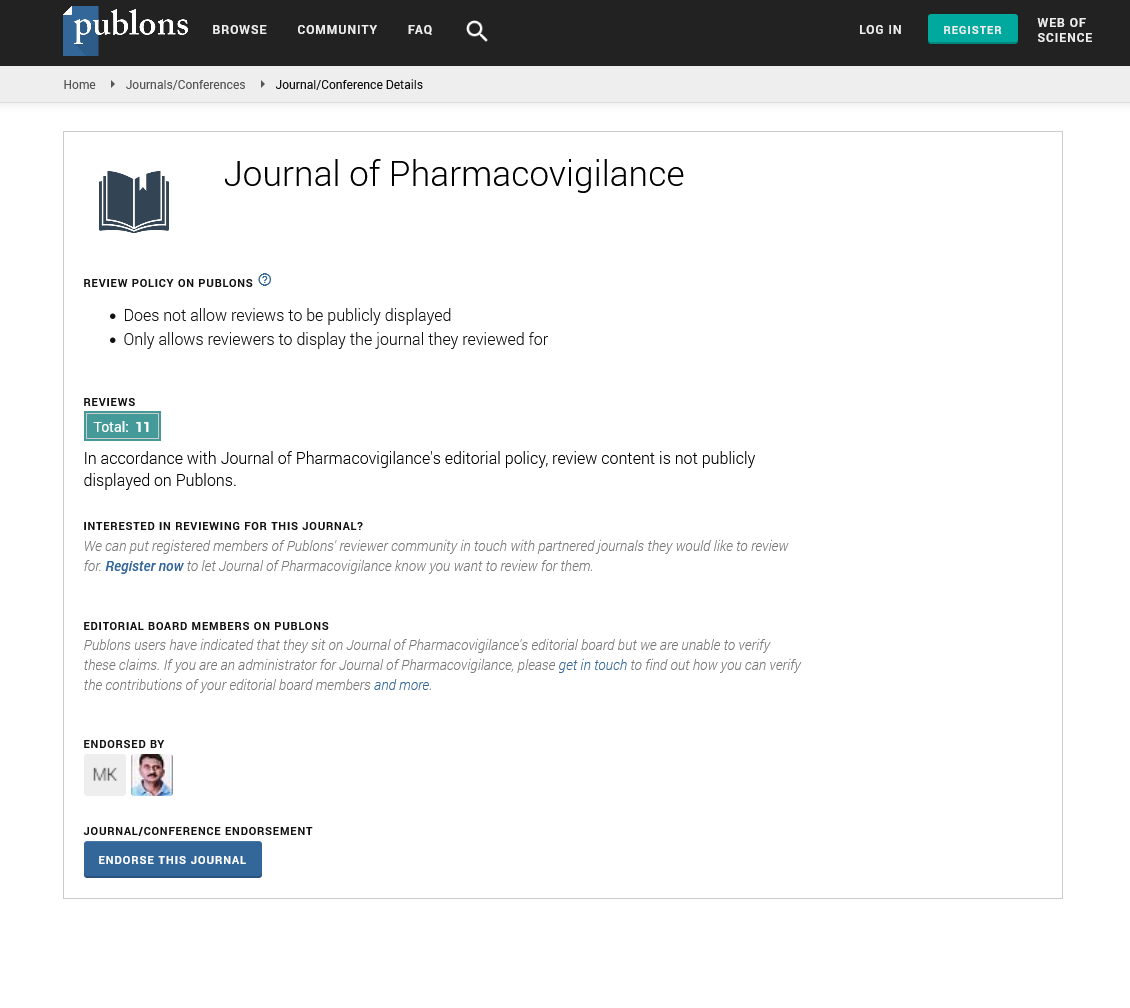Indexed In
- Open J Gate
- JournalTOCs
- The Global Impact Factor (GIF)
- RefSeek
- Hamdard University
- EBSCO A-Z
- OCLC- WorldCat
- Publons
- Euro Pub
- Google Scholar
Useful Links
Share This Page
Journal Flyer

Open Access Journals
- Agri and Aquaculture
- Biochemistry
- Bioinformatics & Systems Biology
- Business & Management
- Chemistry
- Clinical Sciences
- Engineering
- Food & Nutrition
- General Science
- Genetics & Molecular Biology
- Immunology & Microbiology
- Medical Sciences
- Neuroscience & Psychology
- Nursing & Health Care
- Pharmaceutical Sciences
Opinion Article - (2024) Volume 12, Issue 3
Direct-to-Consumer Advertising and its Implications for Pharmacovigilance
Jasper Thorne*Received: 28-Aug-2024, Manuscript No. JP-24-27168; Editor assigned: 30-Aug-2024, Pre QC No. JP-24-27168(PQ); Reviewed: 13-Sep-2024, QC No. JP-24-27168; Revised: 20-Sep-2024, Manuscript No. JP-24-27168(R); Published: 27-Sep-2024, DOI: 10.35248/2329-6887.24.12.485
Description
Direct-To-Consumer Advertising (DTCA) of prescription drugs has become a pervasive aspect of modern healthcare communication. This practice involves pharmaceutical companies marketing their products directly to consumers through various media channels, including television, print and digital platforms. While DTCA aims to inform and empower patients by providing information about treatment options, it also raises significant concerns regarding drug safety and the role of pharmacovigilance. This article describes the implications of DTCA for pharmacovigilance, highlighting both the benefits and the challenges associated with this marketing strategy. DTCA has its roots in the United States, where it was first allowed by the Food and Drug Administration (FDA) in the 1980s. The primary rationale behind DTCA is to educate consumers about available treatments, encouraging them to seek medical advice and consider appropriate therapies for their conditions. Proponents argue that DTCA can enhance patient awareness, promote early diagnosis and treatment and foster improve patient-provider communication. However, the practice of DTCA is not without controversy. Critics argue that it can lead to over-prescription, inappropriate use of medications and increased healthcare costs. Moreover, the implications of DTCA for pharmacovigilance and drug safety warrant careful consideration. DTCA can raise awareness about potential side effects of medications, prompting consumers to report adverse reactions to healthcare providers and regulatory agencies. This increased reporting can enhance pharmacovigilance efforts by providing a larger pool of data on Adverse Drug Reaction (ADRs), facilitating the early detection of safety signals. By providing information about treatment options, DTCA empowers patients to take an active role in their healthcare. Informed patients are more likely to engage in discussions with their healthcare providers about the benefits and risks of medications, contributing to a more comprehensive understanding of drug safety. DTCA can improve health literacy by educating consumers about medical conditions and available treatments. This increased knowledge can lead to better adherence to prescribed therapies and more effective management of chronic diseases, ultimately contributing to improved patient outcomes. One of the primary concerns with DTCA is the potential for misleading or incomplete information. This can create unrealistic expectations and lead to inappropriate use of medications, complicating pharmacovigilance efforts. DTCA can contribute to over-prescription and polypharmacy, particularly among vulnerable populations such as older adults. The promotion of multiple medications can increase the risk of drug-drug interactions and ADRs, making it more challenging to monitor and manage drug safety. Ensuring that DTCA provides accurate and balanced information is a significant regulatory challenge.
Regulatory agencies, such as the Food and Drug Administration (FDA), must rigorously review and monitor advertisements to ensure compliance with guidelines. This requires substantial resources and expertise, highlighting the need for robust regulatory frameworks. Regulatory agencies should enforce stricter standards for DTCA, ensuring that advertisements present a balanced view of both benefits and risks. This includes clear, concise and easily understandable information about potential side effects and contraindications. Healthcare providers and public health organizations should take an active role in educating patients about the limitations of DTCA. By providing accurate, evidence-based information, they can help patients make informed decisions and avoid the pitfalls of misleading advertisements. DTCA should be integrated with pharmacovigilance systems to facilitate the reporting and monitoring of ADRs. Encouraging consumers to report adverse reactions and providing accessible reporting mechanisms can enhance data collection and improve drug safety monitoring. Continuous research and evaluation of DTCA's impact on drug safety and patient outcomes are essential. This includes studying the effects of DTCA on prescribing patterns, patient behavior and the reporting of ADRs. The findings can inform policy decisions and guide improvements in DTCA practices. The United States provides a notable example of the interplay between DTCA and pharmacovigilance.
Conclusion
The FDA oversees DTCA and requires pharmaceutical companies to present a fair balance of benefits and risks in their advertisements. Despite these regulations, there have been instances where advertisements have been found to be misleading or incomplete, leading to regulatory actions and fines. For example, in 2009, the FDA issued a warning letter to a pharmaceutical company for a DTCA campaign that overstated the benefits of a cholesterol-lowering drug while minimizing its risks. This case underscores the importance of stringent regulatory oversight and the need for continuous monitoring of DTCA practices. To address these challenges, the FDA has implemented several initiatives, including the "Bad Ad Program," which encourages healthcare providers to report misleading advertisements. Additionally, the FDA conducts regular reviews of DTCA materials and requires pre-approval of certain advertisements to ensure compliance with regulations.
Citation: Thorne J (2024). Direct-to-Consumer Advertising and its Implications for Pharmacovigilance. J Pharmacovigil. 12:485.
Copyright: © 2024 Thorne J. This is an open-access article distributed under the terms of the Creative Commons Attribution License, which permits unrestricted use, distribution, and reproduction in any medium, provided the original author and source are credited.

